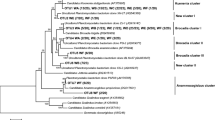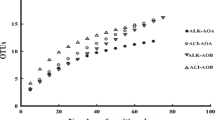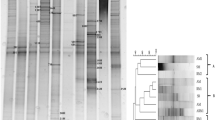Abstract
Purpose
Anammox bacteria have been widely investigated in both natural aquatic habitats and wastewater treatment reactors. However, their distribution in agricultural ecosystems which receive high reactive nitrogen input is hardly known. This study aims to examine the distribution and diversity of anammox bacteria in different Chinese paddy soils and along soil profile horizons.
Materials and methods
DNA was extracted from paddy soils which were collected from ten sites and along four soil depth horizons (0–20, 20–40, 40–60, 60–80 cm). Community structure and diversity of the anammox bacteria were analyzed using cloning and sequencing methods by targeting 16S ribosomal RNA (rRNA) genes. Quantitative PCR was conducted to study the abundance of anammox hzsB genes.
Results and discussion
Anammox bacterial 16S rRNA genes were not detected in most of the surface soil profile layers but present in all subsurface and deep horizons. Two genera, Candidatus Brocadia and Candidatus Kuenenia, were the only groups detected, and the former was predominant in tested soils. A site-specific distribution pattern of anammox bacteria and significant relationship between anammox bacteria community composition and soil pH and ammonium concentration were observed. The abundance of anammox bacteria hzsB gene ranged from 3.78 × 104 to 1.64 × 107 per gram of dry soil in all soils and significantly varied along the soil profile horizons.
Conclusions
Anammox bacteria were widely distributed in paddy soils, especially in subsurface and profile depth horizons. Candidatus Brocadia and Candidatus Kuenenia were the dominating anammox groups in the tested soils, and the two genera showed a site-specific distribution pattern across large Chinese paddy soil areas and along soil depth profiles.




Similar content being viewed by others
References
Chen H, Liu S, Yang F, Xue Y, Wang T (2009) The development of simultaneous partial nitrification, ANAMMOX and denitrification (SNAD) process in a single reactor for nitrogen removal. Bioresour Technol 100:1548–1554
Crowe SA, Canfield DE, Mucci A, Sundby B, Maranger R (2012) Anammox, denitrification and fixed-nitrogen removal in sediments from the Lower St. Lawrence Estuary. Biogeosciences 9:4309–4321
DeAngelis KM, Silver WL, Thompson AW, Firestone MK (2010) Microbial communities acclimate to recurring changes in soil redox potential status. Environ Microbiol 12:3137–3149
Dong LF, Smith CJ, Papaspyrou S, Stott A, Osborn AM, Nedwell DB (2009) Changes in benthic denitrification, nitrate ammonification, and anammox process rates and nitrate and nitrite reductase gene abundances along an estuarine nutrient gradient (the Colne estuary, United Kingdom). Appl Environ Microbiol 75:3171–3179
Gori F, Tringe SG, Kartal B, Marchiori E, Jetten MS (2011) The metagenomic basis of anammox metabolism in Candidatus ‘Brocadia fulgida’. Biochem Soc T 39:1799–1804
Han P, Gu JD (2013) More refined diversity of anammox bacteria recovered and distribution in different ecosystems. Appl Microbiol Biotechnol 97:3653–3663
Hirsch MD, Long ZT, Song B (2011) Anammox bacterial diversity in various aquatic ecosystems based on the detection of hydrazine oxidase genes (hzoA/hzoB). Microb Ecol 61:264–276
Hou L, Zheng Y, Liu M, Gong J, Zhang X, Yin G, You L (2013) Anaerobic ammonium oxidation (anammox) bacterial diversity, abundance, and activity in marsh sediments of the Yangtze Estuary. J Geophys Res 118:1237–1246
Hu HW, Zhang LM, Dai Y, Di HJ, He JZ (2013) pH-dependent distribution of soil ammonia oxidizers across a large geographical scale as revealed by high-throughput pyrosequencing. J Soils Sediments 13:1439–1449
Humbert S, Tarnawski S, Fromin N, Mallet MP, Aragno M, Zopfi J (2010) Molecular detection of anammox bacteria in terrestrial ecosystems: distribution and diversity. ISME J 4:450–454
Jetten MS, Niftrik L, Strous M, Kartal B, Keltjens JT, Op den Camp HJ (2009) Biochemistry and molecular biology of anammox bacteria. Crit Rev Biochem Mol 44:65–84
Kumar S, Nei M, Dudley J, Tamura K (2008) MEGA: a biologist-centric software for evolutionary analysis of DNA and protein sequences. Brief Bioinforma 9:299–306
Kuypers MM, Lavik G, Woebken D, Schmid M, Fuchs BM, Amann R, Jorgensen BB, Jetten MSM (2005) Massive nitrogen loss from the Benguela upwelling system through anaerobic ammonium oxidation. Proc Natl Acad Sci U S A 102:6478–6483
Lam P, Lavik G, Jensen MM, van de Vossenberg J, Schmid M, Woebken D, Gutierrez D, Amann R, Jetten MSM, Kuypers MMM (2009) Revising the nitrogen cycle in the Peruvian oxygen minimum zone. Proc Natl Acad Sci U S A 106:4752–4757
Li M, Gu JD (2013) Community structure and transcript responses of anammox bacteria, AOA, and AOB in mangrove sediment microcosms amended with ammonium and nitrite. Appl Microbiol Biotechnol 97:9859–9874
Long A, Heitman J, Tobias C, Philips R, Song B (2013) Co-occurring anammox, denitrification, and codenitrification in agricultural soils. Appl Environ Microbiol 79:168–176
Mulder A, van der Graaf AA, Robertson LA, Kuenen JG (1995) Anaerobic ammonium oxidation discovered in a denitrifying fluidized bed reactor. FEMS Microbiol Ecol 16:177–184
Risgaard-Petersen N, Meyer RL, Revsbech NP (2005) Denitrification and anaerobic ammonium oxidation in sediments—effects of microphytobenthos and NO3. Aquat Microb Ecol 40:67–76
Rooks C, Schmid MC, Mehsana W, Trimmer M (2012) The depth-specific significance and relative abundance of anaerobic ammonium-oxidizing bacteria in estuarine sediments (Medway Estuary, UK). FEMS Microbiol Ecol 80:19–29
Schloss PD, Handelsman J (2005) Introducing DOTUR, a computer program for defining operational taxonomic units and estimating species richness. Appl Environ Microbiol 71:1501–1506
Schmid M, Twachtmann U, Klein M, Strous M, Juretschko S, Jetten M, Metzger JW, Schleifer KH, Wagner, M (2000) Molecular evidence for genus level diversity of bacteria capable of catalyzing anaerobic ammonium oxidation. Systematic and Applied Microbiology 23:93–106
Schmid MC, Maas B, Dapena A, van de Pas-Schoonen K, van de Vossenberg J, Kartal B, van Niftrik L, Schmidt I, Cirpus I, Kuenen JG, Wagner M, Sinninghe Damste JS, Kuypers M, Revsbech NP, Mendez R, Jetten MS, Strous M (2005) Biomarkers for in situ detection of anaerobic ammonium-oxidizing (anammox) bacteria. Appl Environ Microbiol 71:1677–1684
Schmid MC, Risgaard-Petersen N, van de Vossenberg J, Kuypers MM, Lavik G, Petersen J, Hulth S, Thamdrup B, Canfield D, Dalsgaard T, Rysgaard S, Sejr MK, Strous M, den Camp HJ, Jetten MS (2007) Anaerobic ammonium-oxidizing bacteria in marine environments: widespread occurrence but low diversity. Environ Microbiol 9:1476–1484
Schmid M, Schmitz-Esser S, Jetten M, Wagner M (2011) 16S‐23S rDNA intergenic spacer and 23S rDNA of anaerobic ammonium‐oxidizing bacteria: implications for phylogeny and in situ detection. Environ Microbiol 3:450–459
Shen JP, Zhang LM, Zhu YG, Zhang JB, He JZ (2008) Abundance and composition of ammonia-oxidizing bacteria and ammonia-oxidizing archaea communities of an alkaline sandy loam. Environ Microbiol 10:1601–1611
Shen LD, Liu S, Lou LP, Liu WP, Xu XY, Zheng P, Hu BL (2013) Broad distribution of diverse anaerobic ammonium-oxidizing bacteria in Chinese agricultural soils. Appl Environ Microbiol 79:6167–6172
Wang Y, Zhu G, Harhangi HR, Zhu B, Jetten MS, Yin C, Op den Camp HJ (2012a) Co-occurrence and distribution of nitrite-dependent anaerobic ammonium and methane-oxidizing bacteria in a paddy soil. FEMS Microbiol Lett 336:79–88
Wang S, Zhu G, Peng Y, Jetten MS, and Yin C (2012b) Anammox bacterial abundance, activity, and contribution in riparian sediments of the Pearl River estuary. Environ Sci Technol 46:8834–8842
Wang J, Gu JD (2013) Dominance of Candidatus Scalindua species in anammox community revealed in soils with different duration of rice paddy cultivation in Northeast China. Appl Microbiol Biotechnol 97:1785–1798
Wang TF, Gu JD (2014) Effects of allylthiourea, salinity, and pH on ammonia/ammonium-oxidizing prokaryotes in mangrove sediment incubated in laboratory microcosms. Appl Microbiol Biotechnol 98:3257–3274
Yamamoto T, Takaki K, Koyama T, Furukawa K (2008) Long-term stability of partial nitritation of swine wastewater digester liquor and its subsequent treatment by Anammox. Bior Tech 99(14):6419–6425
Zhu ZL, Chen DL (2002) Nitrogen fertilizer use in China—contributions to food production, impacts on the environment and best management strategies. Nutr Cycl Agroecosys 63:117–127
Zhu G, Wang S, Feng X, Fan G, Jetten MS, Yin C (2011) Anammox bacterial abundance, biodiversity and activity in a constructed wetland. Environ Sci Technol 45:9951–9958
Acknowledgments
This work was financially supported by the National Science Foundation of China (41090281, 41025004, 41322007). We would like to thank Prof. Wenxue Wei and Ms. Yijun Zhu for their assistance in soil sampling and Drs. Peng Cao and Yu Dai for their help in soil physiochemical analysis.
Author information
Authors and Affiliations
Corresponding author
Additional information
Responsible editor: Yanfen Wang
Electronic supplementary material
Below is the link to the electronic supplementary material.
ESM 1
(DOCX 205 kb)
Rights and permissions
About this article
Cite this article
Bai, R., Chen, X., He, JZ. et al. Candidatus Brocadia and Candidatus Kuenenia predominated in anammox bacterial community in selected Chinese paddy soils. J Soils Sediments 15, 1977–1986 (2015). https://doi.org/10.1007/s11368-015-1131-5
Received:
Accepted:
Published:
Issue Date:
DOI: https://doi.org/10.1007/s11368-015-1131-5




